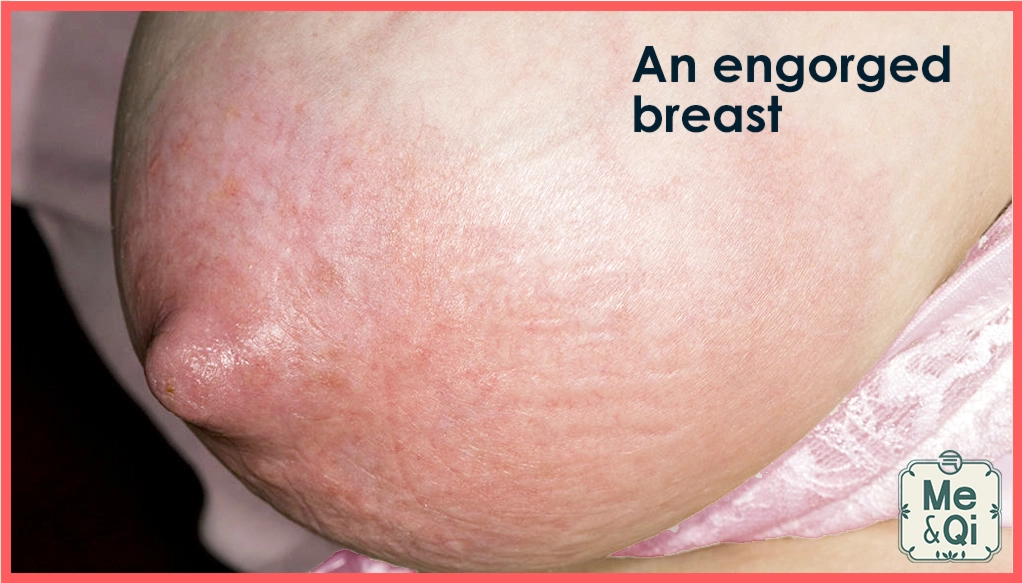This post is part of our complete guide on treating engorgement and clogged ducts. Refer back to the guide if you want a complete list of topics covered, from prevention to diagnosis and treatment. If you're specifically interested in learning to identify whether you have engorgement or clogged ducts, please read on!
How do you know if you have engorgement or clogged ducts?
Breasts engorgement and clogged ducts (sometimes called “plugged ducts” or "blocked ducts") are slightly different issues but they both have the same cause.
Fundamentally they're caused by a mismatch between supply and demand: you have too much unexpressed milk that's accumulated in your breasts.
Recognizing engorged breasts
You know you have engorged breasts when your whole breasts are swollen, hard and relatively painful to the touch. Sometimes only one breast is engorged, sometimes both.
On top of being swollen, the skin of your breasts often appears red and shiny and your nipple may also appear flattened and tight.
Engorgement often occurs at the very start of your breastfeeding when your body is still getting used to the concept, although it can also occur later on if you for instance make big changes to your breastfeeding rhythm.

Recognizing clogged ducts
You know you have a clogged duct if you notice a hard lump or a small engorged area of engorgement on one of your breasts. The area in question typically feels hard, painful and hot to the touch and often looks reddish.
You can have a clogged duct at any point of your breastfeeding although it is more common in the first few weeks or when you change breastfeeding habits.
Preventing and relieving engorgement and clogged ducts
If you have engorged breasts or clogged ducts, it's important you do something about it. If you let the issue linger, it might worsen into mastitis, an extremely painful infection of the breasts.
There are three proven things you can do to relieve engorgement and clogged ducts.
1) Empty your breasts and adopt a steady breastfeeding rhythm
Given that the likely cause of your engorged breasts or clogged ducts is an accumulation of unexpressed breast milk, it stands to reason that expressing that milk will go a long way towards solving the issue! You can do so by breastfeeding or pumping, it doesn't matter: having engorged breasts or clogged ducts doesn't affect the quality of your milk. The only important thing is to ensure you've thoroughly emptied your breasts.
It's also crucial you adopt a steady breastfeeding or pumping rhythm. Like this you give a chance to your body to learn when to fill your breasts. If for instance you decide not to breastfeed during the night and you do so consistently, you’ll observe that your body will progressively send less milk to your breasts during the night. Your body learns that there is no point sending milk to your breasts during that time-span.
The worse you can do is confuse your body by changing your breastfeeding schedule all the time. If you do so you never give your body a chance to adapt and your engorgement issues will linger.
2) Drink Unblock Nursing Tea

On top of keeping a steady rhythm, you can also help mitigate your engorgement issues by drinking a specialized herbal tea like Unblock Nursing Tea. It’s a herbal tea designed to help you deal with engorged breasts and plugged ducts.
If you have existing engorgement or clogged duct issues, you should consider drinking 3 tea bags of it a day (re-using each tea bag once or twice). If your goal is merely to prevent engorgement, 1 tea bag a day is enough.
3) Consider getting a breast massage
Getting your breasts massaged by a specialist (like a lactation or a Gua-Sha massage therapist) has been proven scientifically to reduce engorgement1. A couple of sessions should be enough to relieve the pain substantially.
So to summarize, how do you know if you have engorgement or clogged ducts?
- You know you have engorgement if one or both of your breasts are swollen, hard and relatively painful to the touch.
- You know you have clogged ducts if you notice a hard lump or a small area of engorgement in one of your breasts that feels hard, painful and hot to the touch.
- To relieve engorgement or clogged ducts, empty your breasts, adopt a stead rhythm, drink Unblock Nursing Tea and get a breast massage.
> Back to our complete guide on engorgement and clogged ducts
Sources:
1. Chiu J-Y, Gau M-L, Kuo S-Y, et al. Effects of Gua-Sha therapy on breast engorgement: A randomized controlled trial. J Nurs Res2010;18:1–10

